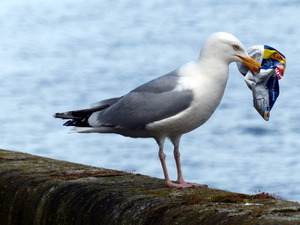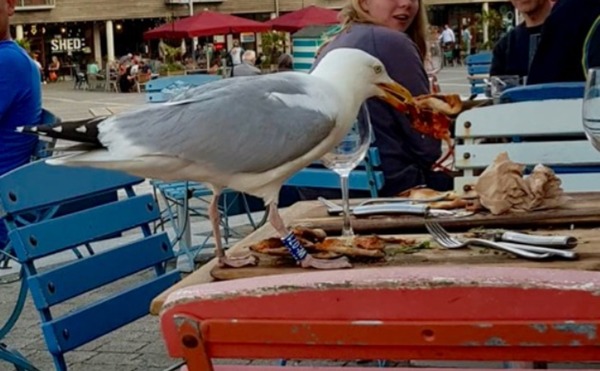 LINKED PAPER
LINKED PAPER
Factors associated with Herring Gulls Larus argentatus stealing food from humans in coastal towns. Raghav, S. & Boogert, N.J. 2023 Bird Study. doi: 10.1080/00063657.2022.2162846 VIEW
Increasing overlap between anthropogenic landscapes and wildlife habitats has given rise to more human-wildlife conflicts (Nyhus 2016). The European Herring Gull (Larus argentatus) employs a foraging strategy, kleptoparasitism, that unsurprisingly leads to conflict with humans. This food stealing behaviour is rather under-studied in towns where, debatably, most human-gull conflict lies (Rock 2005). As humans are not the only hosts that gulls target, we were interested in delving deeper into what makes coastal towns such a popular foraging ground.
Food stealing behaviour is only beneficial under certain ecological conditions (Brockmann & Barnard 1979). The large concentration of hosts is one such factor, which even without any formal investigation, can be assumed to be present in towns. In line with this, we conducted our observational study in areas within towns where the spatial concentration of hosts would be high. The second factor that we looked at, which affects the success of this particular strategy, was reliable food availability. In part, human hosts ensure this by eating meals in the same designated spaces. However, where food becomes available is not the only predictable factor, when food becomes available is also highly predictable. Most gull stealing attempts were observed between 12pm to 1pm when most people have lunch. This high temporal predictability further makes towns ideal foraging hotspots.
As would be expected, changes in food availability itself predicted increase and decrease in gull stealing attempts. However, this was only after taking location into account. In certain locations, gull stealing attempts were more for the same amount of food availability. One possible reason for these location specific trends in behaviour may be due to the layout of these towns as large seafronts make it easier to escape after theft. This fidelity in behaviour for different locations can be better understood with further work. Another factor where food availability alone did not explain changes in kleptoparasitic behaviour, was season. For the purposes of our study, the data collected prior to the official tourist season was labelled “Pre-tourist” season. Tourist season saw more stealing attempts from gulls as compared to the Pre-tourist season. This could be due to tourists spending more time in areas that are accessible to gulls such as outdoor seating or differences in attention; many factors possibly explain this result. They are worth exploring in the future.
While all these factors are essential, the biggest hurdle in employing this foraging strategy is the risk of injury or worse. In the case of humans, we found that this risk is relatively low. Our observations showed that 60% of people simply covered their face or food when a gull made a stealing attempt. While there were negative responses such as shouting, nobody attempted to physically harm the bird. The final factor which makes this strategy viable is the success rate; Herring Gulls were successful in 50% of their stealing attempts. If compared to other host species, this is on the higher end (Källander 2006). Though, we couldn’t determine whether it was a few gulls that repeatedly engaged in food stealing behaviour or many gulls. This would affect how success rate can be interpreted.

Figure 1 A Herring Gull helping itself to leftover pizza at a restaurant in Falmouth © Emma Inzani.
Food stealing behaviour appears to be a low-risk and high-reward strategy in towns. Previously mentioned factors made towns ideal for employing this foraging strategy. If conflict is to be reduced, these factors need to be considered.
References
Nyhus, P.J. 2016. Human–wildlife conflict and coexistence. Annual Review of Environment and Resources 41:143-171. VIEW
Rock, P. 2005. Urban gulls: problems and solutions. British Birds 98:338-355. VIEW
Brockmann, H.J. & Barnard, C.J. 1979. Kleptoparasitism in birds. Animal Behaviour 27:487-514. VIEW
Källander, H. 2006. Interspecific kleptoparasitism by four species of gull Larus spp. in South Sweden. Ornis Svecica 16:127-149. VIEW
Image credit
Top right: © Mat Fascione CC BY SA 2.0 Geograph.
If you want to write about your research in #theBOUblog, then please see here.




